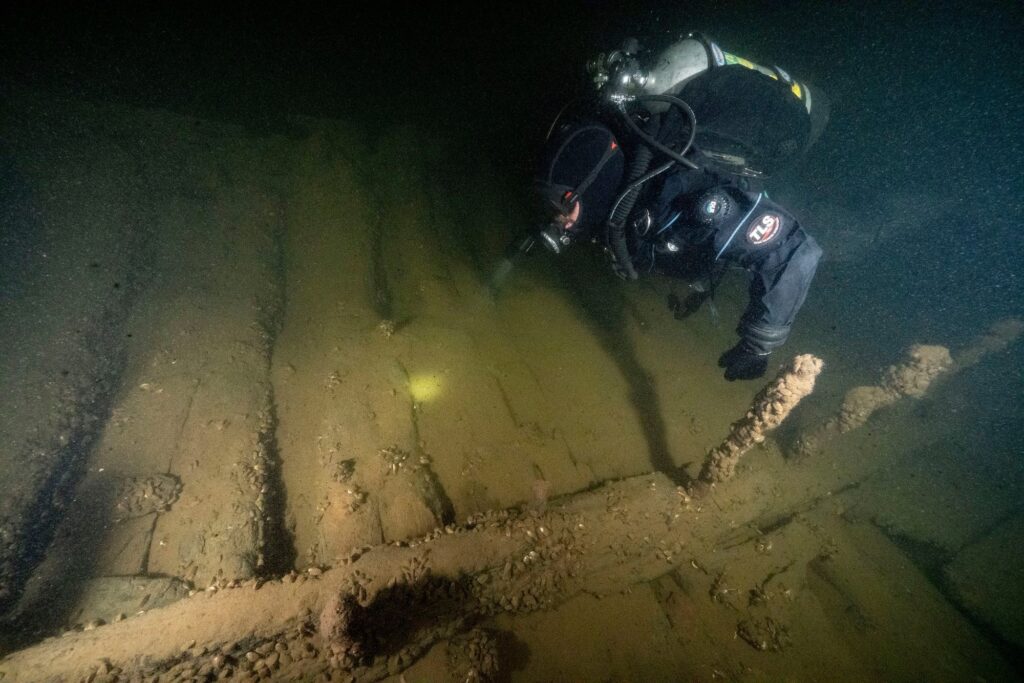Steam technology entered the transportation world in 1783, with the experimental steamship Pyroscaphe built by Marquis de Jouffroy d’Abbans and demonstrated on the Saône River in France.
While there is some debate on the inventor of the steam-powered boat in the US, as evidence suggests Vermont inventor Samuel Morey invented a small steam engine before Robert Fulton, there is no debate that currently the oldest known evidence of a steamboat rests in Lake Champlain. The steamboat Phoenix is both a tragic tale of loss and an example of exciting archaeological discovery.

Detail of a Lake Champlain Steamboat Company Poster from April 30, 1817 advertising the steamboats Phoenix and Champlain from Steamboats of Lake Champlain by Ogden Ross.
Phoenix was the second commercial steamboat built on Lake Champlain. Built by the Lake Champlain Steamboat Company and launched in 1815, Phoenix was commanded by Captain Jahaziel Sherman and maintained a regular schedule between Whitehall, NY and St. Johns, Quebec, with stops at other lake ports along the route.
The Tragedy
On September 4, 1819, at 11:00 pm, Phoenix set out on its regular route from Burlington, VT for Plattsburgh, NY with 46 passengers and crew, under the command of Captain Sherman’s son, Richard. An unusual glow in the amidships galley provided the first warning that a fire had broken out on board, but the discovery was made too late to save Phoenix.

Phoenix Burning, Painting by Ernest Haas. Lake Champlain Maritime Museum Collection.
The passengers were roused from their cabins and loaded into two small boats. Unfortunately, in the confusion, a dozen people, including the captain, were left to fend for themselves on the burning ship. Sherman and several others were rescued from the lake in the morning, but six others were not so lucky and tragically perished in the cold, dark waters of Lake Champlain. The cause of the fire was said to have been a candle carelessly left burning in the pantry; however, circumstantial evidence suggests that the fire may have been intentionally set by competing interests.
Archaeological Discoveries
During the winter of 1819-20, the charred hull remains of Phoenix were trapped in ice and dragged partially off Colchester Shoal where it sank and was lost for over 150 years. The vessel was rediscovered by scuba divers and researchers in 1978. The first archaeological documentation of Phoenix took place in 1980 by a team from the Champlain Maritime Society, a predecessor to Lake Champlain Maritime Museum.

The hull of Phoenix by Pierre LaRoque.
The shipwreck scene is large and dramatic: the wreck is 146 feet long and 27 feet wide. Fire-charred ends of floor frames and the hull are clearly visible. The bow sits in 60 feet of water, jutting 15 feet off the bottom of the lake. The wreck follows the downward slope of the lakebed, dropping down to the stern which rests at a depth of 110 feet below the lake. Rudder hardware is visible at the stern and iron rods which held the engines and boilers are also visible. The boat’s iconic paddlewheels are missing, and it was assumed at the time of its discovery in 1978 that the paddlewheels had been lost in the fire and the charred hull was all that remained of Phoenix.

Archaeological site plan of Phoenix by George Schwarz, 2011
While none of the original engineering plans of Phoenix have ever been found, a team with Lake Champlain Maritime Museum conducted an extensive investigation of the shipwreck. Using the existing data such as engine bed timbers, fasteners, copper pipes, brick, and ash they were able to deduce a lot about the construction of this early steamboat and create the detailed plan above.


Left: One of the first visuals of the mysterious structures found on the lakebed by Gary Lefebvre in August 2020. / Right: The discovery of the paddlewheels confirmed and new imagery captured on September 6, 2020 by Michael MacDonald.
In 2020, local shipwreck researchers Gary and Ellen Lefebvre found a curious object on their sonar near the Colchester Shoal and explored it using an underwater remote operated vehicle (ROV). Gary recorded the footage and shared the clip with the archaeology team at Lake Champlain Maritime Museum. The structures discovered were clearly the paddlewheels of an early sidewheel steamboat. After taking into account the location of the paddlewheels about ¾ of a mile away from the site of Phoenix wreck and the extensive charring that could clearly be seen on the paddlewheels where they would be mounted to the boat, it became apparent he had discovered the lost paddlewheels of Phoenix.
What We Can Learn
The paddlewheels of Phoenix are the oldest archaeological remains of steamboat paddlewheels in the world, and they provide us a new glimpse into the earliest era of this technology. The Museum’s research and archaeology team is conducting ongoing research and surveys of the site of Phoenix and the paddlewheels to create detailed 3D photogrammetry models and put them together to create the most accurate model to date of an early American steamboat.

Museum Director Chris Sabick (center) with Kevin Crisman (right) and George Schwarz (left) recovered this unique bearing block from the Phoenix wreck site and are conducting careful conservation to understand how early paddlewheels were mounted to the vessel.
The Phoenix hull is listed on the National Register of Historic Places and it was the first dive site added to the Lake Champlain Underwater Historic Preserves. This ensures the site is protected under federal law and managed locally for public divers to visit during dive season in Lake Champlain from June–October each year. For those who can’t dive, explore underwater footage of this unique wreck on the Museum’s YouTube Channel here.
All together this shipwreck is truly unique for Lake Champlain and throughout the country. Our team has discovered the paddlewheel mounting technology of early steamboat construction. We look forward to continuing to share discoveries from this important shipwreck site.

